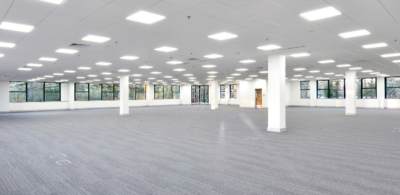In this series of posts on global workplace trends, my workplace strategy colleagues and I will explore the five core areas where we believe businesses around the world must make significant progress over the next five years. The first shift centers around the most valuable asset within every company: the employees.
While most business leaders understand the importance of employee engagement, three-quarters of those surveyed in a recent study said that most employees are not highly engaged. This presents a variety of missed opportunities and even business risks. On average, happy employees have 31% higher productivity, 37% higher sales performance and a level of creativity three times higher than their unhappy counterparts. Research also shows the direct impact that engagement and productivity can have on the bottom line: Public companies with engaged workforces report higher earnings per share.
In the same way that businesses focus on delivering excellent customer experiences, companies must also focus on creating a superior employee experience to succeed. This challenge becomes even more interesting in an environment where technology is making it easier to work from just about anywhere.
Think about the way this is playing out in the retail sphere. As e-commerce makes it temptingly simple to avoid stepping foot in an actual store, bricks-and-mortar retailers are finding new ways to draw shoppers in by providing authentic experiences that can’t be replicated online. In the same way, employers must provide engaging employee experiences in order to realize the benefits of the physical workplace, from fostering cultural cohesion to inspiring innovation through personal interaction.
One of Colliers’ clients is a global consulting firm whose employees spend the majority of their time traveling and visiting clients. To foster connectivity and engagement, the company created a “come home day” every Friday, when employees are encouraged to come into the office to work, but more importantly to meet, socialize, train, mentor and be mentored — all as an effective way to maintain the culture and drive business.
Roadmap to 2022: Create an “Owner” of Employee Experience
Employee engagement often falls into a corporate no man’s land. Is it Human Resources’ responsibility? Corporate Communications’ responsibility? Management’s responsibility? While each of these teams and more should play a role, in the coming years we expect a greater focus on designating an “owner” of employee experience: the “CXO” or Chief Experience Officer.
This role or team will function as the company “cruise director,” focused on engagement, productivity and curating experiences that make the workplace attractive and “sticky.” Think about what it would mean to your employees to have access to interesting speakers, inspiring exhibits and fitness activities, let alone moments of spontaneity that create delight and drive innovation throughout the workday.
Remember that old adage, “what gets measured gets done”? By dedicating a person or team to creating a rewarding employee experience and establishing metrics for accountability, businesses can make significant progress in this area.
There are many lessons to be learned from co-working companies like WeWork. One is the “community manager” role WeWork has created at every location — a person who coordinates everything from book clubs to technology seminars to Easter egg hunts.
These types of activities can encourage connection, relationship-building and even help uncover new business opportunities. WeWork co-founder Adam Neumann calls it the creation of a “physical social network,” or a place where authentic interactions happen.
Source: “WeWork cultivating ‘physical social network’,” Financial Times
A heightened focus on employee experience also helps create a “bleisure” environment, blending business and leisure. As it becomes simpler to work anywhere, anytime, we must be more purposeful about where we build in time for fun, relaxation and socialization.
If you can create an office environment where work and play are blended, you can drive more collaboration and innovation. We expect that the three primary methods to this will persist:
- The Campus Approach. Some companies see a tie between productivity, engagement and employees spending as much time as possible in the workplace. Companies like Google have set the standard in shaping behavior this way — bringing the fun, food and relaxation to the work campus. In a world of choices, they have made their workplaces into attractors — making them the first and best choices for their target employees to work.
- The Neighborhood Approach. Within some company cultures, relaxation and socialization are strategically centered “off campus.” With this approach, the key is securing a location near the right features and conveniences to make your workspace and the surrounding environment attractive to employees. Booking.com’s new Amsterdam office (slated to open in 2020) will be a good example of this strategy, given its location in Oosterdokseiland — a growing hub of urban business, recreation and entertainment.
- The Shared Amenities Approach. Smaller companies might find it difficult to provide a cafeteria or other amenities within their own offices. As a result, it’s becoming increasingly important that landlords of multi-tenant facilities provide these kinds of spaces for occupants’ shared use. Service providers like Convene work with building owners to create conferencing spaces and casual meeting hubs, complete with food and technology that draw tenants in.
International design and consulting firm IDEO hosts a daily “Tea Time” in their offices. Employees drop their work and mingle with colleagues for 10 minutes over tea and cookies. These “casual collisions” create connectivity between people and foster creativity.
Source: “How to Unlock the Creative Magic at Your Company,” Inc.
Roadmap to 2022: Bring the Hospitality Mindset into the Workplace
A fully-stocked break room or a weekly ping pong tournament are great ways to engage the workforce, but an equally important focus is improving the employee experience by reducing “friction.” Things that slow or stop work from getting done can wear on employee morale and motivation as they build up the level of “frustration time.” The flip side is that removing barriers or delays — the friction — can not only make work more efficient, but also more engaging.
One of the ways companies can do this is by putting the concierge model you find in the hospitality arena to work in the office setting. Hotels are all about a service-oriented mentality and a commitment to doing whatever it takes to meet guests’ needs. We’ve seen businesses achieve impactful results by translating this mindset into a workplace concierge service — one central place people can come with needs and questions. We’ve found that nearly 60% of typical workplace issues can be resolved on the spot, rather than through the extended, impersonal process of contacting a service center.
Beyond helping employees with room scheduling, event preparation and technology issues, more companies will start to provide services that reduce friction in employees’ personal lives as well. The hospitality model acknowledges the simple fact that the pressures of life affect performance in the workplace. By addressing both the internal and external sources of friction, employees can better focus on high-priority business issues. If employees can quickly schedule a car maintenance appointment through a concierge service, they are left with more time to dedicate to productive work or leisure — both of which can contribute to engagement.
In its new office in Barangaroo, Australian bank Westpac provides 6,000 employees with a concierge service backed by Colliers’ Workplace Management Services. Staffed by hospitality-trained professionals, the concierge desk provides everything from dry-cleaning services to help with technical equipment to restaurant reservations.
Westpac and other companies are increasingly finding that to attract and retain the best talent, it’s essential to take workplace design and facilities management to the next level. And it’s working: since opening the new office, Westpac has noted that absenteeism is down 15%.
Source: “Westpac raises the bar at new Barangaroo digs,” The Sydney Morning Herald
While the hospitality model has distinct benefits for employees, it also creates a meaningful feedback loop that allows for more proactive facilities management. By constantly assessing requests and issues through a centralized, service-oriented function, companies can feed that information into continually improving their processes.
Get Started Now
Think about what defines your employee experience today and where you have the greatest opportunities to move the needle in meeting the needs of tomorrow’s employees. Do you know what your employees value? Do you know where they consistently experience friction?
If you can create a service-oriented mindset toward employee engagement and true ownership of the employee experience, you can create meaningful change within your organization.
This post is part of a series on the five workplace trends that Colliers’ global workplace experts see as the most crucial for companies to align with in the next five years. Stay tuned for upcoming installments and a full white paper coming soon. In the meantime, contact the workplace expert in your region for more insights and information.
Contact
Americas
Keith Perske
Head of Workplace Solutions
Keith.Perske@colliers.com
+1 512 673 3653
Australia & New Zealand
Peter Black
Head of Workplace Solutions
Peter.Black@colliers.com
+61 2 9249 2065
EMEA
JanJaap Boogaard
Head of Workplace Solutions
JanJaap.Boogaard@colliers.com
+31 10 412 00 35
North Asia
Truddy Cheung
Head of Workplace Solutions
Truddy.Cheung@colliers.com
+852 2822 0584
Southeast Asia
Samarth Kasturia
Head of Workplace Solutions
Samarth.Kasturia@colliers.com
+65 6531 8685

 Workplace Advisory
Workplace Advisory
 Aaron Jodka
Aaron Jodka
 Amber Merrigan
Amber Merrigan
 Andrew Steele
Andrew Steele